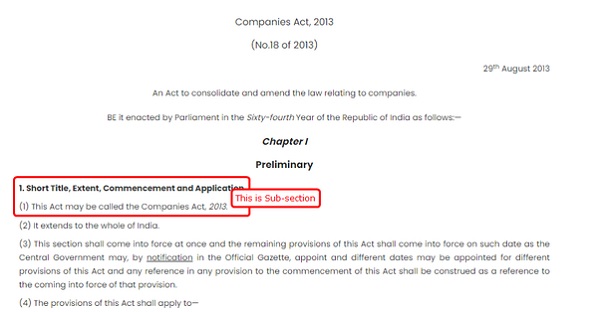What is difference between sub-section and clause? How do I identify whether the provision is a sub-section or a clause?
Introduction: Hello, my name is Bablu, and as a CA student deeply engrossed in the intricacies of legal statutes, I’ve observed a common misconception among students regarding the differentiation between sub-sections and clauses within a section of an Act. Many believe that if a provision directly relates to a section, it’s termed a sub-section, and if not, it’s referred to as a clause. Today, I’m here to debunk this myth with a clear explanation supported by visual examples.
Most of the students think that if a provision is part of a section, then it will be a sub-section otherwise clause, but I am damn sure you all are wrong. Let me prove it.
These are the two Images

–

So, if any provision starts directly without any line or word, it’s a subsection (image 1).
And if any provision starts with some explanations, it’s a clause (image 2).
In picture 1, there is a section short title, extent, commencement, and application. And without any further explanation, there is point no. 1; this is a subsection.
In picture no. 2, there is a section, and then there is some explanation after that point (a); it’s a clause.
Now, you will say, “My teacher told me if a provision is related to a section, then it’s called a subsection; otherwise, it’s a clause.” Let me be clear, you all are wrong.
Detailed Explanation:
The differentiation between “sub-section” and “clause” within any given section of a legal document, such as legislation, is crucial for understanding the structure and application of laws. These terms represent hierarchical levels within legal texts, enabling a precise and organized presentation of legal provisions. Understanding their distinctions is fundamental for legal practitioners, students, and anyone interested in the intricacies of legislative writing.
Sub-section
A sub-section is a division of a section within a statute or legal document. It is used to further break down and elaborate on the provisions contained in a section, making the law more detailed and specific. Sub-sections are typically denoted by numbers or letters within parentheses or brackets and follow the main provision of the section to which they belong. They allow for an orderly arrangement of ideas, making complex legal concepts easier to navigate and understand. For example, if Section 10 of a law discusses a broad legal principle, Section 10(1), Section 10(2), etc., would explore specific applications or exceptions to this principle.
Clause
A clause, in the context of legal statutes, refers to a particular provision or condition within a section or a sub-section. Clauses are usually identified by numbers or letters and provide for specific stipulations, conditions, or qualifications to the broader legal principle outlined in the section or sub-section. Clauses can be further divided into sub-clauses if the need arises to detail further or specify conditions or provisions. This division helps in dissecting complex legal language into manageable, understandable parts.
Key Differences
- Hierarchical Level: Sub-sections exist at a hierarchical level directly beneath sections. They are used to expand on the general principles laid out in a section. Clauses are found within sections or sub-sections and detail specific provisions or conditions.
- Function: Sub-sections are meant to break down and elaborate on the content of a section, making the law clearer and more detailed. Clauses are used to specify conditions, stipulations, or qualifications to the legal provisions detailed in a section or sub-section.
- Identification: Sub-sections are typically denoted by numbers or letters in parentheses (e.g., 10(1)), while clauses are identified by numbers or letters following the sub-section designation they belong to (e.g., 10(1)(a)).
- Complexity and Detail: Sub-sections are used to elaborate on the content of sections, often adding complexity and detail. Clauses, and potentially sub-clauses, further dissect these details into precise legal language, specifying conditions or provisions with greater specificity.
Understanding the distinction between sub-sections and clauses is vital for navigating legal documents effectively. It allows for a more precise interpretation of laws, aiding legal professionals, students, and the general public in understanding the specific requirements, obligations, and rights established by legislation.
Have a good day.






It was really helpful brother. I never bothered thinking about it so much during my study period, but since now in my office i need to thoroughly go through the laws, i am able to understand the difference